#to serve maximus's characterization is 'more interesting'.
Explore tagged Tumblr posts
Text
maximus isn't boring people just are tuning out the "selfishness vs selflessness+often questionable morality but ultimately wants to do the right thing+ also he's in a cult that he sees the cracks in but chooses to ignore because he thinks rising up in rank in the BoS is his best path to have the power to do good" arc
#also. a lot of ppl hating on vaultknight sound like reyIos#i think the biggest problem with his characterization is just that we didn't spend enough time focused on him? which sucks.#but you're not seriously pretending you think dane who's on screen for like four minutes and at this point mainly exists#to serve maximus's characterization is 'more interesting'.#logan watches fallout
61 notes
·
View notes
Text

𓂀 𝙱𝙻𝚄𝙴 𝙷𝙰𝚁𝙱𝙾𝚁 𝚃𝙰𝚂𝙺 𝟶𝟶𝟷 — 𝙿𝙴𝚁𝚂𝙾𝙽𝙰𝙻𝙸𝚃𝚈.
"What we do in life, echoes in eternity." ~ Maximus Decimus Meridius, Gladiator (2000)
📜The Meyer's Briggs Personality Test: 𝙴𝙽𝙵𝙹 ~ 𝚃𝚑𝚎 𝙿��𝚘𝚝𝚊𝚐𝚘𝚗𝚒𝚜𝚝
ENFJ (Protagonist) is a personality type with the Extraverted, Intuitive, Feeling, and Judging traits. These warm, forthright types love helping others, and they tend to have strong ideas and values. They back their perspective with the creative energy to achieve their goals.
People with the ENFJ personality type (Protagonists) feel called to serve a greater purpose in life. Thoughtful and idealistic, ENFJs strive to have a positive impact on other people and the world around them. These personalities rarely shy away from an opportunity to do the right thing, even when doing so is far from easy.
ENFJs are born leaders, which explains why these personalities can be found among many notable politicians, coaches, and teachers. Their passion and charisma allow them to inspire others not just in their careers but in every arena of their lives, including their relationships. Few things bring people with the ENFJ personality type a deeper sense of joy and fulfillment than guiding friends and loved ones to grow into their best selves.
📜The Morality Alignment Test: 𝙻𝚊𝚠𝚏𝚞𝚕 𝙶𝚘𝚘𝚍
A lawful good character acts as a good person is expected or required to act. He combines a commitment to oppose evil with the discipline to fight relentlessly. He tells the truth, keeps his word, helps those in need, and speaks out against injustice. A lawful good character hates to see the guilty go unpunished.
Lawful good is the best alignment you can be because it combines honor and compassion.
Lawful good can be a dangerous alignment when it restricts freedom and criminalizes self-interest.
📜The 5 Love Languages Test: 𝚀𝚞𝚊𝚕𝚒𝚝𝚢 𝚃𝚒𝚖𝚎
Your Love Tank overflows with Quality Time. You prize undivided attention from others. Spending meaningful and uninterrupted time together profoundly impacts your emotional world. Whether it’s in deep conversations or sharing experiences together with a loved one who is fully present and engaged, Quality Time conveys that you are a top priority and deeply loved.
📜The Four Temperaments Test: 𝚂𝚊𝚗𝚐𝚞𝚒𝚗𝚎
The sanguine personality is characterized by a cheerful disposition, lively energy, and a generally positive and optimistic outlook on life. Sanguine individuals tend to be highly social, extroverted, and enthusiastic, often possessing a contagious sense of humor that makes them the life of the party. They are usually creative, imaginative, and tend to be very entertaining.
Sanguine individuals are also spontaneous and can be seen as impulsive at times. They have a tendency to live in the moment, which often leads to them being adaptable and flexible in different situations. They tend to be more interested in the present than in future plans or consequences. This trait, however, can also lead to difficulty in maintaining focus, staying organized, and following through on tasks.
Moreover, sanguine people are often charismatic and are able to influence and inspire others with their vibrant energy and contagious enthusiasm. Their natural ability to create and maintain relationships often leads to a large network of friends and acquaintances.
On the flip side, the sanguine temperament may lack depth in the analysis of situations and can sometimes take things too lightly, even when seriousness is required. This can lead to a tendency towards forgetfulness and disorganization. Their desire for social acceptance and fear of rejection can also make them overly sensitive to criticism.
Overall, sanguine individuals are warm-hearted, buoyant, and carefree, bringing lightness and joy to their environments and interactions. Despite their potential challenges, they have a unique ability to rebound from disappointments with their resilient optimism.
📜Western Zodiac Signs: 𝙻𝚎𝚘
Element: Fire
Color: Gold, Yellow, Orange
Quality: Fixed
Day: Sunday
Ruler: Sun
Greatest Compatibility: Aquarius, Gemini
Lucky Numbers: 1, 3, 10, 19
Personality Traits
Strengths: Creative, passionate, generous, warm-hearted, cheerful, humorous
Weaknesses: Arrogant, stubborn, self-centered, lazy, inflexible
Leo likes: Theater, taking holidays, being admired, expensive things, bright colors, fun with friends
Leo dislikes: Being ignored, facing difficult reality, not being treated like a king or queen
People born under the sign of Leo are natural born leaders. They are dramatic, creative, self-confident, dominant and extremely difficult to resist, able to achieve anything they want to in any area of life they commit to. There is a specific strength to a Leo and their "king of the jungle" status. Leo often has many friends for they are generous and loyal. Self-confident and attractive, this is a Sun sign capable of uniting different groups of people and leading them as one towards a shared cause, and their healthy sense of humor makes collaboration with other people even easier.
Ruled by the Sun, Leo worships this fiery entity in the sky, quite literally as well as metaphorically. They are in search for self-awareness and in constant growth of ego. Aware of their desires and personality, they can easily ask for everything they need, but could just as easily unconsciously neglect the needs of other people in their chase for personal gain or status. When a Leo representative becomes too fond and attached to their achievements and the way other people see them, they become an easy target, ready to be taken down.
The story of the Lion always speaks of bravery. This is an animal fearless and impossible to challenge, hurt or destroy, their only weaknesses being fear and aggression towards those they confront. Living in a cave, a Lion always needs to have one, nesting and finding comfort in hard times. However, they should never stay there for long. With their head high, they have to face others with dignity and respect, never raising a voice, a hand, or a weapon, bravely walking through the forest they rule.
📜Celtic Tree Zodiac Signs: 𝙷𝚘𝚕𝚕𝚢 ~ 𝚃𝚑𝚎 𝚁𝚞𝚕𝚎𝚛
Among the Celtic tree astrology signs the Holly is one of regal status. Noble, and high-minded, those born during the Holly era easily take on positions of leadership and power. If you are a Holly sign you take on challenges easily, and you overcome obstacles with rare skill and tact. When you encounter setbacks, you simply redouble your efforts and remain ever vigilant to obtain your end goals. Very seldom are you defeated. This is why many people look up to you and follow you as their leader. You are competitive and ambitious even in the most casual settings. You can appear to be arrogant but in actuality, you’re just very confident in your abilities. Truth be known, you are quite generous, kind and affectionate (once people get to know you). Highly intelligent, you skate through academics where others may struggle. Because many things come to you so easily, you may have a tendency to rest on your laurels. In other words, if not kept active, you may slip into an unhealthy and lazy lifestyle. Holly signs may look to Ash and Elder signs for balance and partnership.
1 note
·
View note
Text
The 15 most important Monuments of Rome, Italy

For centuries time seems to have stopped in Rome, the Eternal City. But it must be said that this is a very lively city that still has its 3,000 years of history latent since it was founded by the Romulus and Remus brothers. Being the ancient capital of the Roman Empire, the city dominated the entire Mediterranean basin and much of Europe. It was one of the first major metropolises in the world and its historical legacy and influence are enormous, even reaching our days. For centuries, the greatest emperors wanted to leave their mark on history by building monuments at the height of their power ... and their ego. Thus came the Colosseum, the Pantheon of Agrippa, the Circus Maximus or the Arch of Constantine. Later religion came and with it the construction of the greatest temples of Catholicism. Gods, Emperors, and Popes contributed to the fact that today the city of Rome is the city with the most millenary historical monuments in the world.
The most visited Rome Monuments
These are some of the best and most visited monuments of the Italian capital. An essential route on your trip through the Eternal City. Roman Coliseum

Colosseum is the best-known monument in Rome The Colosseum is the best-known monument in Rome and is considered a symbol of the city. This imposing construction, with more than 2,000 years of history, was built during the Flavian dynasty. It was built in the 1st century AD. C. under the mandate of Vespasiano, although its construction lasted 8 years, already with Emperor Titus in power. At that time it was the largest Roman amphitheater, with 188 m long, 155 m wide and 57 m high. Their bleachers could welcome more than 50,000 spectators, who enjoyed amazing shows: wild animal hunting, executions, gladiatorial fighting, and naumachia, among other games. Today, it is one of the 7 Wonders of the World and one of the most visited monuments. St. Peter's Basilica
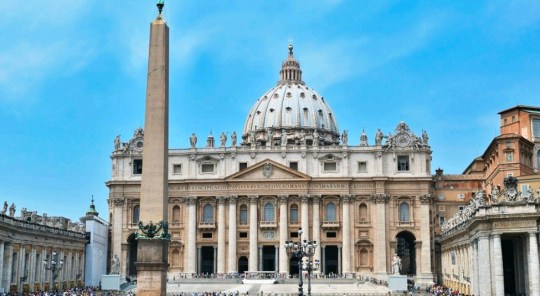
Basilica of San Pedro del Vaticano is the most important religious temple in Rome, Italy The Basilica of San Pedro del Vaticano is the most important religious temple of Catholicism, which also houses the Holy See. Inside, St. Peter, the first Pope, is buried. Its construction (1506-1626) was carried out by some of the most famous architects of the time, such as Bramante, Miguel Ángel and Carlo Maderno. Some of the most important works of art found inside are the Bernini Baldachin, the Pieta by Michelangelo, the statue of St. Peter on his throne and the incredible dome that crowns the Basilica. Within the Vatican, we have another essential visit; The Vatican Museums, the largest art collection in the world. Roman Forum
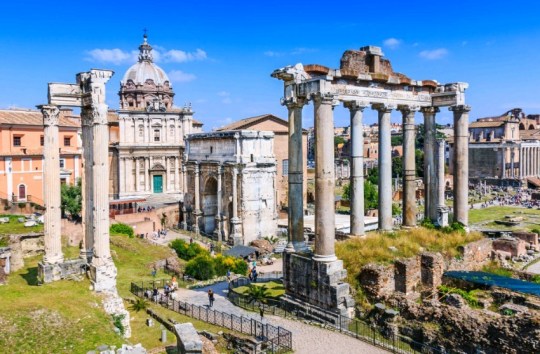
Roman Forum is a must-visit Monuments in Rome The Roman Forum was the central area of the ancient city and one of the must-visit Monuments in Rome. There were the governmental institutions, the market, and the religious temples. When walking through it you can visit multiple monuments, buildings and ruins of great interest, such as the Via Sacra, the Arch of Titus and the Temples of Vesta and Saturn, among others. Its location has no loss, since it is next to the famous Roman Colosseum. Fontana di Trevi

Trevi Fountain is one of the most beautiful, monumental and visited fountains in the world The Trevi Fountain is one of the most beautiful, monumental and visited fountains in the world. His unmistakable baroque style is due to the almost unknown artist Nicola Salvi . This began its construction in the eighteenth century, but it took about 30 years to finish it. One of the features that attract the most attention is how impressive the fountain is with all these realistic figures and how small the square is in which it is located. It has also become almost a ritual to throw a coin inside the fountain and make a wish. From returning to Rome to marry an Italian! Piazza del Campidoglio
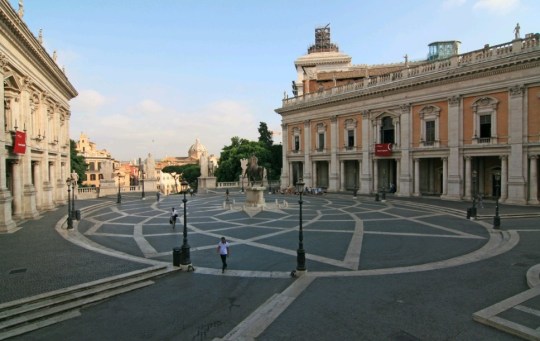
Piazza of the Campidoglio is a wonderful space located on Capitoline Hill, Rome, Italy The Piazza of the Campidoglio is a wonderful space located on Capitoline Hill. It was an order of Pope Paul III to Michelangelo after the visit of King Charles I in 1536. Michelangelo built this square with a trapezoidal plant and oriented it towards the Basilica of St. Peter. In the square, you can also visit the magnificent New Palace, climb its beautiful staircase of the Cordonata and admire the equestrian statue of Marco Aurelio. Pantheon of Agrippa

Pantheon of Agrippa is the best-preserved monument in Rome The Pantheon of Agrippa is the best-preserved monument in Rome and is located in the center of the city, it is also one of the most visited. Its construction was carried out in the year 126 a. C., when Adriano ruled. Its main feature is that it is a circular building since its circumference measures the same as its height: 43.3 m. Its interior preserves the tombs of some of the most important kings of Italy and valuable works of art. The great painter Rafael is also buried here. Piazza Navona

Piazza Navona is one of the most beautiful and important squares of Rome The Piazza Navona is one of the most beautiful and important squares of Rome. All of it is a monument in itself. Characterized by its baroque style, this square is located in the heart of the city. The most famous monuments of the square are the Fountain of the Rivers and the church of Santa Agnese in Agone. It is also a very lively and lively place, ideal for dining out, as it is visited by many tourists, and where many street artists show their works. Spain Square

Piazza of Spain is one of the places most famous and interesting in Rome The Piazza of Spain and stairways between the Piazza di Spagna and Piazza Trinità dei Monti' is one of the places most famous and interesting in Rome. It is called that because the Spanish embassy is located here since the 17th century. This is one of the most important areas of the city, since the Via Dei Condotti, Frattina and dei Babuino converge. One of its architectural features is its famous staircase, which has 135 steps. Although itself, it cannot be considered a Monument of Rome, we include it for its importance in the most visited places in Rome. Popolo Square

Piazza del Popolo has always been considered the door of Rome The Piazza del Popolo has always been considered the door of Rome, as it was from there known as Via Flaminia, which connected the imperial capital with the rest of Europe. Three straight streets converge on the square, where a monumental obelisk stands. One of the most important reasons to visit Popolo Square is the Church of Santa Maria of the Popolo. The two very valuable works of Caravaggio are conserved that must be essential in your visit to this beautiful place. Sant´Angelo Castle

Castillo de Sant´Angelo is an impressive fortress, also called Hadrian's Mausoleum The Castillo de Sant´Angelo is an impressive fortress, also called Hadrian's Mausoleum, as it was built under the government of the emperor. Its construction began in 135 and finished 4 years later. In 403 the Aurelian Wall was built. On the castle rests the impressive statue of an angel. To get to the castle, you must walk the fortified corridor of 800 m in length. This corridor was built to connect with the Vatican and help the Pope to flee if necessary. Basilica of San Clemente

Basilica de San Clemente is one of the most important in the history of religion The Basilica de San Clemente receives its name from Pope Clement I. This building is one of the most important in the history of religion since it belongs to the first era of Christianity. Here clandestine meetings of the first Christians were held, but it was not until 313 AD. C., after finishing the persecution of the Christians, when it happened to be considered basilica. In it, you can visit an ancient church of the fourth century, decorated with rich mosaics. Santa María la Mayor
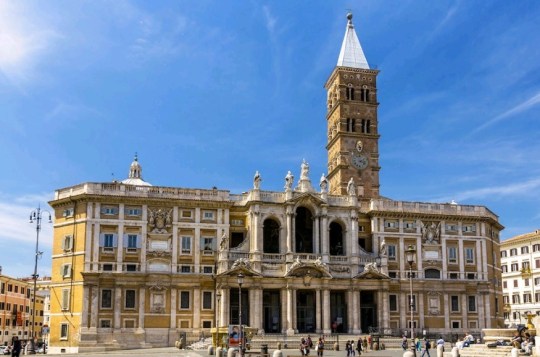
Basilica of Santa Maria Maggiore was built in the 5th century and is the only one in Rome The Basilica of Santa Maria Maggiore was built in the 5th century and is the only one in Rome that still has its paleochristian plant. In addition, it was the first religious building dedicated to the Virgin Mary. Its interior is monumental and impressive. In it, you can admire magnificent paleochristian mosaics of the 5th century, 27 panels of Roman times and the so-called Grotto of the Nativity, where relics of the manger in which Jesus Christ was born are preserved. The Catacombs

Roman catacombs are impressive underground galleries that served as a place of burial The Roman catacombs are impressive underground galleries that served as a place of burial. There are buried ancient Roman citizens, Jews, and the first Christians. Its construction began in the second century AD. C. and were completed in the fifth century. Some of the most important catacombs in the city are those of San Sebastián, San Calixto, Priscila, Domitila and Santa Inés. Basilica of San Giovanni in Laterano

Basilica di San Giovanni in Laterano is the most important of the city's major basilicas and one of the most beautiful The Basilica di San Giovanni in Laterano is the most important of the city's major basilicas and one of the most beautiful. It is also the Cathedral of Rome. Its construction was carried out in the fourth century, under the orders of Constantine, and its name was placed in honor of Saint John the Baptist and the Evangelist Saint John. Of great interest is its portico, where the Pope officiates the liturgy of Holy Thursday; the statues of Christ and several saints; the bronze door; the Holy Stairs; and its interior, which is of unparalleled beauty. Basilica of Saint Paul Outside the Walls

Basilica de San Pablo Extramuros is one of the most beautiful buildings in Rome The Basilica de San Pablo Extramuros is one of the most beautiful buildings in Rome. Its construction was carried out in the fourth century, under the mandate of Constantine. Inside, rest the remains of the great Apostle St. Paul. In 1813, a great fire destroyed it completely and its restoration lasted more than a century. On your visit, you should not miss the Apostle's tomb, the Arnolfo de Cambio ciborium, the apse mosaic, the Easter candleholder, the Byzantine door, and the Arc de Triomphe mosaic. Images via Wikimedia, Adobe Stock, Shutterstock. Read the full article
#BestDestination#bestplacestotravel#Blog#Destinations#Europe#FontanadiTrevi#PantheonofAgrippa#PiazzaNavona#PiazzaoftheCampidoglio#RomanForum#Rome#Top#Travel#Traveling
0 notes
Text
The 15 most important Monuments of Rome, Italy

For centuries time seems to have stopped in Rome, the Eternal City. But it must be said that this is a very lively city that still has its 3,000 years of history latent since it was founded by the Romulus and Remus brothers. Being the ancient capital of the Roman Empire, the city dominated the entire Mediterranean basin and much of Europe. It was one of the first major metropolises in the world and its historical legacy and influence are enormous, even reaching our days. For centuries, the greatest emperors wanted to leave their mark on history by building monuments at the height of their power ... and their ego. Thus came the Colosseum, the Pantheon of Agrippa, the Circus Maximus or the Arch of Constantine. Later religion came and with it the construction of the greatest temples of Catholicism. Gods, Emperors, and Popes contributed to the fact that today the city of Rome is the city with the most millenary historical monuments in the world.
The most visited Rome Monuments
These are some of the best and most visited monuments of the Italian capital. An essential route on your trip through the Eternal City. Roman Coliseum

Colosseum is the best-known monument in Rome The Colosseum is the best-known monument in Rome and is considered a symbol of the city. This imposing construction, with more than 2,000 years of history, was built during the Flavian dynasty. It was built in the 1st century AD. C. under the mandate of Vespasiano, although its construction lasted 8 years, already with Emperor Titus in power. At that time it was the largest Roman amphitheater, with 188 m long, 155 m wide and 57 m high. Their bleachers could welcome more than 50,000 spectators, who enjoyed amazing shows: wild animal hunting, executions, gladiatorial fighting, and naumachia, among other games. Today, it is one of the 7 Wonders of the World and one of the most visited monuments. St. Peter's Basilica

Basilica of San Pedro del Vaticano is the most important religious temple in Rome, Italy The Basilica of San Pedro del Vaticano is the most important religious temple of Catholicism, which also houses the Holy See. Inside, St. Peter, the first Pope, is buried. Its construction (1506-1626) was carried out by some of the most famous architects of the time, such as Bramante, Miguel Ángel and Carlo Maderno. Some of the most important works of art found inside are the Bernini Baldachin, the Pieta by Michelangelo, the statue of St. Peter on his throne and the incredible dome that crowns the Basilica. Within the Vatican, we have another essential visit; The Vatican Museums, the largest art collection in the world. Roman Forum

Roman Forum is a must-visit Monuments in Rome The Roman Forum was the central area of the ancient city and one of the must-visit Monuments in Rome. There were the governmental institutions, the market, and the religious temples. When walking through it you can visit multiple monuments, buildings and ruins of great interest, such as the Via Sacra, the Arch of Titus and the Temples of Vesta and Saturn, among others. Its location has no loss, since it is next to the famous Roman Colosseum. Fontana di Trevi

Trevi Fountain is one of the most beautiful, monumental and visited fountains in the world The Trevi Fountain is one of the most beautiful, monumental and visited fountains in the world. His unmistakable baroque style is due to the almost unknown artist Nicola Salvi . This began its construction in the eighteenth century, but it took about 30 years to finish it. One of the features that attract the most attention is how impressive the fountain is with all these realistic figures and how small the square is in which it is located. It has also become almost a ritual to throw a coin inside the fountain and make a wish. From returning to Rome to marry an Italian! Piazza del Campidoglio

Piazza of the Campidoglio is a wonderful space located on Capitoline Hill, Rome, Italy The Piazza of the Campidoglio is a wonderful space located on Capitoline Hill. It was an order of Pope Paul III to Michelangelo after the visit of King Charles I in 1536. Michelangelo built this square with a trapezoidal plant and oriented it towards the Basilica of St. Peter. In the square, you can also visit the magnificent New Palace, climb its beautiful staircase of the Cordonata and admire the equestrian statue of Marco Aurelio. Pantheon of Agrippa
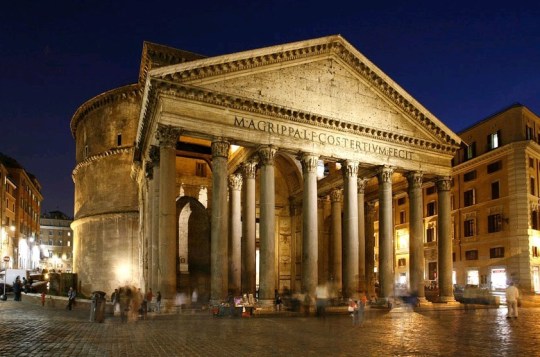
Pantheon of Agrippa is the best-preserved monument in Rome The Pantheon of Agrippa is the best-preserved monument in Rome and is located in the center of the city, it is also one of the most visited. Its construction was carried out in the year 126 a. C., when Adriano ruled. Its main feature is that it is a circular building since its circumference measures the same as its height: 43.3 m. Its interior preserves the tombs of some of the most important kings of Italy and valuable works of art. The great painter Rafael is also buried here. Piazza Navona

Piazza Navona is one of the most beautiful and important squares of Rome The Piazza Navona is one of the most beautiful and important squares of Rome. All of it is a monument in itself. Characterized by its baroque style, this square is located in the heart of the city. The most famous monuments of the square are the Fountain of the Rivers and the church of Santa Agnese in Agone. It is also a very lively and lively place, ideal for dining out, as it is visited by many tourists, and where many street artists show their works. Spain Square
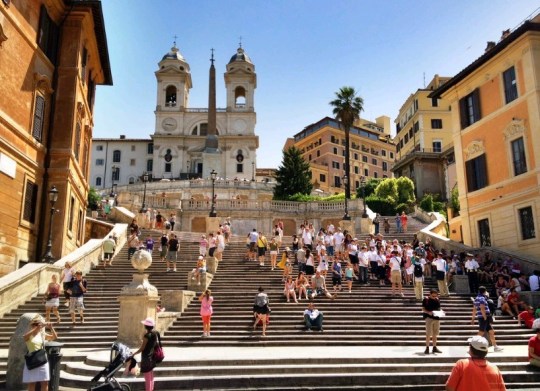
Piazza of Spain is one of the places most famous and interesting in Rome The Piazza of Spain and stairways between the Piazza di Spagna and Piazza Trinità dei Monti' is one of the places most famous and interesting in Rome. It is called that because the Spanish embassy is located here since the 17th century. This is one of the most important areas of the city, since the Via Dei Condotti, Frattina and dei Babuino converge. One of its architectural features is its famous staircase, which has 135 steps. Although itself, it cannot be considered a Monument of Rome, we include it for its importance in the most visited places in Rome. Popolo Square

Piazza del Popolo has always been considered the door of Rome The Piazza del Popolo has always been considered the door of Rome, as it was from there known as Via Flaminia, which connected the imperial capital with the rest of Europe. Three straight streets converge on the square, where a monumental obelisk stands. One of the most important reasons to visit Popolo Square is the Church of Santa Maria of the Popolo. The two very valuable works of Caravaggio are conserved that must be essential in your visit to this beautiful place. Sant´Angelo Castle

Castillo de Sant´Angelo is an impressive fortress, also called Hadrian's Mausoleum The Castillo de Sant´Angelo is an impressive fortress, also called Hadrian's Mausoleum, as it was built under the government of the emperor. Its construction began in 135 and finished 4 years later. In 403 the Aurelian Wall was built. On the castle rests the impressive statue of an angel. To get to the castle, you must walk the fortified corridor of 800 m in length. This corridor was built to connect with the Vatican and help the Pope to flee if necessary. Basilica of San Clemente

Basilica de San Clemente is one of the most important in the history of religion The Basilica de San Clemente receives its name from Pope Clement I. This building is one of the most important in the history of religion since it belongs to the first era of Christianity. Here clandestine meetings of the first Christians were held, but it was not until 313 AD. C., after finishing the persecution of the Christians, when it happened to be considered basilica. In it, you can visit an ancient church of the fourth century, decorated with rich mosaics. Santa María la Mayor
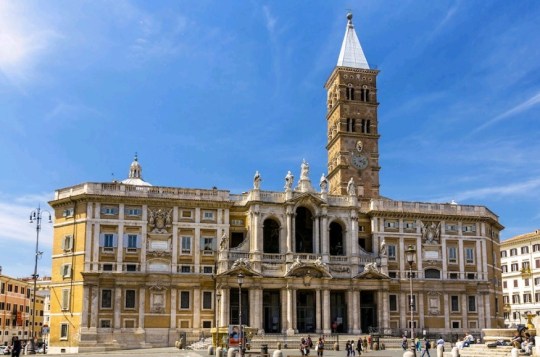
Basilica of Santa Maria Maggiore was built in the 5th century and is the only one in Rome The Basilica of Santa Maria Maggiore was built in the 5th century and is the only one in Rome that still has its paleochristian plant. In addition, it was the first religious building dedicated to the Virgin Mary. Its interior is monumental and impressive. In it, you can admire magnificent paleochristian mosaics of the 5th century, 27 panels of Roman times and the so-called Grotto of the Nativity, where relics of the manger in which Jesus Christ was born are preserved. The Catacombs
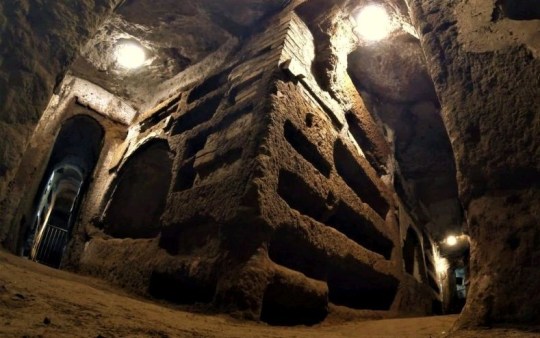
Roman catacombs are impressive underground galleries that served as a place of burial The Roman catacombs are impressive underground galleries that served as a place of burial. There are buried ancient Roman citizens, Jews, and the first Christians. Its construction began in the second century AD. C. and were completed in the fifth century. Some of the most important catacombs in the city are those of San Sebastián, San Calixto, Priscila, Domitila and Santa Inés. Basilica of San Giovanni in Laterano
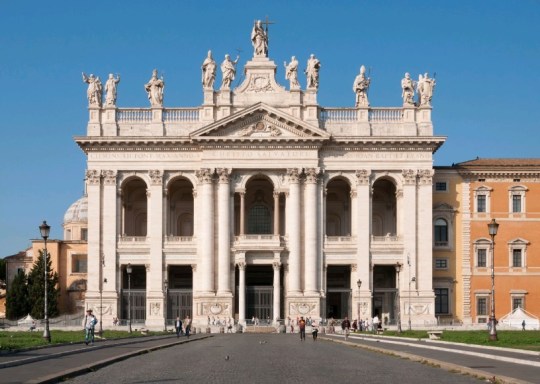
Basilica di San Giovanni in Laterano is the most important of the city's major basilicas and one of the most beautiful The Basilica di San Giovanni in Laterano is the most important of the city's major basilicas and one of the most beautiful. It is also the Cathedral of Rome. Its construction was carried out in the fourth century, under the orders of Constantine, and its name was placed in honor of Saint John the Baptist and the Evangelist Saint John. Of great interest is its portico, where the Pope officiates the liturgy of Holy Thursday; the statues of Christ and several saints; the bronze door; the Holy Stairs; and its interior, which is of unparalleled beauty. Basilica of Saint Paul Outside the Walls

Basilica de San Pablo Extramuros is one of the most beautiful buildings in Rome The Basilica de San Pablo Extramuros is one of the most beautiful buildings in Rome. Its construction was carried out in the fourth century, under the mandate of Constantine. Inside, rest the remains of the great Apostle St. Paul. In 1813, a great fire destroyed it completely and its restoration lasted more than a century. On your visit, you should not miss the Apostle's tomb, the Arnolfo de Cambio ciborium, the apse mosaic, the Easter candleholder, the Byzantine door, and the Arc de Triomphe mosaic. Images via Wikimedia, Adobe Stock, Shutterstock. Read the full article
0 notes
Text
Marvel’s Inhumans Season 1 Review
I didn’t find much to love in Marvel’s latest TV series: I’ve never been a huge Inhumans fan and this did little to change my mind. The show felt prohibitively small-scale, the character arcs were messy even in an eight-episode season, and they took the bizarre position of making the supposed heroes the heads of an oppressive caste system. It seems like budgetary restraints put a cap on power usage, but I feel like we see more action on episodes of Agents of SHIELD than we did on this show. There were many opportunities to go bigger, weirder, and much more interesting in all areas of the series, from design to superpowers to character arcs, but more often than not they chose to play it safe and conventional.
From costumes to sets, the production values for the Inhumans’ hidden moon base Attilan looked far too mundane and ordinary, like you could find them in any location on Earth. Their design choices and way of life didn’t reflect a people that had been separated from humanity for such a long time. Shouldn’t they have wholly disparate customs and outlooks; shouldn’t they essentially be aliens to us at this point? The terrigenesis ceremony, which gives the Inhumans their powers, was the one cultural touchstone that felt like it separated them from any other Earth culture. Attilan should’ve been home to as many strange and wondrous Marvel Easter Eggs as possible—this was their first chance to truly dig into the weirdness of the MCU on TV—but we got none. While Hawai’i was shot well, the rest of the Earth locations didn't really pop either. The set for what was supposed to be a high-tech space agency was an empty warehouse with a big-screen monitor and some desks arranged in front of it.
The characters didn’t fare much better and for the most part, their sojourns in Hawai’i did little to endear them to me. While it was great to have a lead who couldn’t speak and instead used sign language (or a version of it, anyway; like I saw in reviews at the AV Club, there’s no reason for them to speak English but not use ASL), Black Bolt (Anson Mount) wasn’t given many opportunities to do more than glower. When he did get to briefly explore other emotions, like comedic reactions to humans or romance with Medusa (Serinda Swan), Mount was believable, but overall Blackagar Boltagon felt pretty grim the whole time. I didn’t buy the angst of his character: a scene where he accidentally vaporized his parents with his super-destructive voice was so nonchalant it appeared comedic, not tragic. Additionally, Black Bolt did not appear to be a ruler charismatic enough to uphold the oppression the royal family continued forcing on the people of Attilan. His leadership choices didn’t make much sense either: learning of the spread of Inhumans on Earth (as seen on Agents of SHIELD), he secretly sends Triton (Mike Moh) to recover them, complete with a secret rendezvous location in case things go bad. Why wouldn’t he tell Medusa and his master strategist Karnak (Ken Leung)? We’re never given a hint that he distrusts them and it’s clear neither would betray him. How did he send Triton, when the show makes no effort to give Black Bolt the means to communicate without Medusa interpreting for him (the Inhumans have wrist communicators, but the devices don’t have video screens or text readouts) and only Medusa and Maximus (Iwan Rheon) know how to understand his sign language? We’re also told he has a secret bunker that no one else knows about, fully stocked for several lifetimes. What if Black Bolt had been killed in a sneak attack from their “greatest enemy?” Medusa and the rest of his family would’ve never known where they could seek shelter. Keeping secrets like these made no sense and only served to manufacture cheap drama when the other characters found out and (rightly) called him on his bizarre choices. I did like that Black Bolt always maintained his self-control about using his powers, making him a clever foil to Maximus’ obsession with getting abilities, but that wasn’t played with as much as it could’ve been. Finally unleashing his voice to give Maximus the other thing he wanted—to be king of Attilan—was fitting, but I didn’t feel anything from their struggle since they spent so much screentime apart.
Karnak was introduced as an abusive and borderline psychotic womanizer—telling a servant (Jenna Bleu Forti, I believe) that within two days of dating he’d hate her so much he’d want to kill her because he could see her flaws—and his brief fling with a human (Jen, Jamie Grey Hyder) while his powers were on the fritz did nothing to convince me he’d changed. I’ve liked Leung in other roles, but making Karnak likable was a truly uphill battle. That he hit his head and messed up his powers of seeing the flaw in everything because he calmly stepped on a loose rock and fell off a cliff was absurd. Immediately abandoning his quest to find Black Bolt once his powers glitched—not to find out how to fix them, but because he felt useless—made me wonder why he was ever seen as reliable among the royal family. His truly random time on a pot farm was extraneous to the plot (especially once violence was involved), and his self-doubt momentarily changed into completely embracing a carefree lifestyle far too fast, but at least his fling attempted to provoke some character growth by getting him to not look for flaws so much. However, his inability to see them at that point deflates that growth a bit for me. Once he reunited with his family, their biggest reaction to the changes he’d supposedly gone through is that he acts without being absolutely sure now, not that he’s grown as a person or anything. He does defy royal decrees and tradition by putting Gorgon (Eme Ikwuakor) through terrigenesis a second time to resurrect him, but Black Bolt and Medusa scolding him felt half-hearted, so it didn’t seem like that big a breach in protocol. While his dedication to his friend was admirable, he was so abrasive in the beginning that I still didn’t find him likable at the end of his arc.
Questions of competency further arose around Gorgon, who seemed to be the worst head of a royal guard ever. This is a guy who, knowing they have to remain hidden, intentionally crushed exploratory rovers, stole the flag Neil Armstrong planted on the moon for fun, and told a bunch of Earth strangers about their secret moon city right after meeting them. I don’t know if it’s because he never had to actually police anything in Attilan, but he wasn’t written like someone who’d be in charge of security; he was written like a bumbling fool Karnak had to put up with. I get the buddy cop pairing they were going for—Gorgon was the fun impulsive contrast to Karnak’s obsessive planner—but too often Gorgon came off as dumb and Karnak as cruel for me to buy into their friendship very much. Don’t get me wrong; a fun-loving, jovial head of security would be a refreshing change from the standard gruff characterization—Ikwualkor seemed more than up to that task—and it would’ve been fine if Gorgon hadn’t seemed so irresponsible as well. His only response to Karnak telling the servant he’d want to kill her was “You’re your own worst enemy,” which either implies these kinds of comments are so common that he’s decided they can be laughed off or that Gorgon sees Karnak’s sex life as more important than the actual lives of the servants (“say nothing about wanting to kill them—even if you’re thinking it—and they’d sleep with you” was my interpretation of his reaction), or both. Resurrecting him as a somewhat confused “zombie” after a heroic sacrifice (possibly the only truly guard-like thing he did beyond training people to fight in flashbacks) in the later episodes didn’t help matters either. They had a chance to make him see that the royal family’s way of doing things was wrong when a group of Hawai’ian freedom fighters told him about Hawai’i’s history, wherein America forced Hawai’i to give up its monarchy—as if all monarchs are good regardless of who they are—but the writing didn’t let Gorgon realize that Maximus didn’t parallel the imperialistic Americans, Black Bolt and co. did. I found it odd that Gorgon would take these random humans’ advice about strategy for fighting Maximus (staying on Earth to make himself bait so Maximus would bring the fight to him) instead of coming up with one himself. He did have a good idea when he suggested Karnak bluff about still having his power, though, and he did show a little responsibility in eventually telling his freedom fighter pals to back off for their safety; I just wish he’d shown more of this kind of behavior. It seemed like they were afraid to extensively show his hooves, as he wore special boots that made his feet look normal in every action sequence. Triton (Mike Moh) was wasted—maybe the heavy makeup required to bring the character to life prevented them from using him much—and there was no reason for Black Bolt to keep his mission a secret except to create a later moment of internal drama. He did have pretty cool fight scenes at the end of the season, though.
Medusa fared the best by far on the show, and was the one character I was invested in. Even though they cut off her prehensile hair in the first episode—for budgetary/effects reasons, I suppose; for the record, I didn’t think the CGI hair looked bad—robbing her of her trademark powers, her arc was the best-written and acted. At first I thought she was a little too stoic, but Swan did great once Medusa was banished to Hawai’i; her reactions to the loss of her hair—effectively several limbs—were haunting and powerful. I wish we’d gotten more time to see just how intrinsic Medusa’s hair was to her everyday life so we could see how big an impact losing it had on everyday actions (how often does she use her hair when the rest of us would use our hands, for example?) or her fighting style (I did like what little we got to see of her using her hair offensively), but Swan absolutely sold her loss. I liked that her displacement revealed her as a tough fighter (and clever strategist, correctly guessing that Crystal (Isabelle Cornish) was being used to track the royals’ locations) rather than crushing her, though as I’ve seen pointed out elsewhere, a bigger reaction to seeing Maximus again in the end would’ve been appropriate. They could’ve even included the twist the comics did, where she could still control her hair to attack him even after having it cut off. I did like that she destroyed his last chance to get powers by smashing the terrigen crystal just like he stole hers, though. And she got to deliver perhaps the series’ coolest line to Maximus, “Black Bolt wants to have words with you.” Her drive to save her husband—her second call to Black Bolt on their communication devices after arriving on Earth was a great expression of their love—and reunite her family provided the urgency and stakes to the show. While Black Bolt got arrested or captured a lot early on (elaborating on Maximus’ connections on Earth) and everyone else was stuck in subplots that went nowhere and added very little to their character development (mostly they just gained an appreciation for humans, though Karnak and Gorgon once tried thinking like each other to solve problems), Medusa’s arc fit squarely into the narrative and drove most of the action. While she was abrasive when she got to Earth, her burgeoning friendship with Louise (Ellen Woglom) was well-constructed to spark her character development and it’s the one human relationship that felt real and natural. While I would've liked Medusa to spend a little more time dealing with how her rule affected her citizens, taking responsibility for the royal family’s misdeeds and acknowledging that Maximus had the right idea (just like her parents) was a good start, though we probably should’ve seen more of a reckoning for the royals in terms of public reaction to them. I also liked her getting fed up with just being Black Bolt’s interpreter and his lies in general, so I’d be very interested to see what she does with an equal share of the responsibility of ruling. Will she balance her parents’ teachings with the way Black Bolt has been leading, or will she do something entirely different? I would also watch a second season of Medusa and Lockjaw travelling the world to rescue scared and persecuted Inhumans. Medusa and Lockjaw recurring on a Ms. Marvel series, with Medusa teaching Kamala how to be an Inhuman and Kamala teaching her how to respect non-royals and humans, would be welcome too.
Medusa’s sister Crystal had the potential to go in an interesting direction, but they settled for a flimsy romance instead. Maximus seemed to nearly convince her that he was right about the horrible conditions of Inhuman society in Attilan—particularly since her parents had fought against the royalty—and it almost seemed like she might agree. Instead, she escaped Attilan the first chance she got and fell in love with the first human (Chad James Buchanan) she met, who also rammed Lockjaw with his four-wheeler. True it was an accident and he got her dog help, but he also convinced Crystal to go swimming instead of looking for her family in the middle of a coup. From what we saw of Crystal in Attilan, at no point did she need to relax more; even after the coup, Maximus let her hang out in her room. I’m not against romance in superhero stories at all—the soap opera aspect is a core component, dating all the way back to Superman and Lois’ triangle for two—but this wasn’t the time and it paled in comparison to the promise of Crystal more directly interacting with Maximus’ plot. I would have absolutely been on board with her siding with Maximus for the right reasons (minus the overtones of a forced marriage); that would’ve been far more complex and engaging than continuing to draw her as the sheltered princess they did. It also would’ve put her at odds with the rest of her family and built on the backstory of Black Bolt’s parents (Michael Buie, Tanya Clarke) putting hers to death for dissenting against the monarchy. Instead, she got a bland flirtation and her entire role in the final battle against Maximus was to ask a wall (Moses Goods) to teleport everyone to Earth, and she didn’t even have to convince Eldrac to help. Lockjaw was a delight, but he didn’t get to do anything but act as a transporter for everyone else. As I’ve seen pointed out elsewhere, I really wish we’d seen them build their relationship more.
Maximus had all the right motivations—he legitimately had a good argument about the Inhuman caste system throwing people with undesirable or no powers into literal mines (despite the fact that surely powers like Gorgon, Crystal, Karnak, Black Bolt and even Medusa had would make mining easier…no argument that limited resources necessitated the caste system holds up when all the powers useful for labor are wasted on an upper class that does nothing) while those with admirable or beautiful powers were prized—but he was trapped in Attilan without anyone to spar with beyond underlings (another reason Crystal agreeing with him but truly fighting for the greater good would’ve been the better arc). If he wanted an exodus to Earth to ease overpopulation on the moon so badly, why didn’t he just start moving people there as soon as he was in control? Using Eldrac would’ve allowed him to take his people anywhere and the royal family wouldn’t have known or been able to do anything about it. They should’ve been able to hold whatever territory they took or, more intelligently, couldn’t they replicate their camouflaging tech on Earth? Establishing a temporary, invisible home base on Earth where they could collect the newly emerging Inhumans would’ve been better than staying on the moon. Surely fulfilling his promises and leading his people into the future would’ve gone over much better than murdering anyone who opposed him, even with spinning the Genetic Council as the keepers of oppression. It would’ve been a great and complex twist if, in addition to wanting powers, he actually was a good king. When it came to his selfish impulses, he came off as another Loki scheming for power, and while I’ve seen the suggestion that an Inhumans show with multiple “houses” could’ve been the superhero Game of Thrones, that’s much harder to do when there’s only one house. The reveal that Maximus had been communicating with people on Earth and was in command of the soldiers who “killed” Triton was a genuine surprise to me, and I wish there had been more examples of his Machiavellian schemes. On the other hand, forging his parents’ signature on a decree to have Black Bolt lobotomized—inadvertently leading to Black Bolt killing them—had no effect on me; it just seemed so haphazard and random, like it was tacked on to give Black Bolt additional reason to hate Maximus. Having Maximus send out soldiers to attack the royal family got old (though at least they used super powers), and perhaps it wouldn’t have seemed so perfunctory if the royals hadn’t all had their powers undermined right off the bat. Maximus and his loyalists would’ve had to be that much more cunning and powerful if they were dealing with a royal family that had functioning superpowers instead of a scattered array of lost souls, which would’ve made for a more exciting series instead of watching drug dealers try to kill Karnak and random freedom fighters team up with Gorgon. I wish they could’ve given him his second terrigenesis to push him further into madness. I also wish we’d seen his friendship with Medusa—in flashbacks or in the present—since it was apparently so important to him; that would’ve added an understanding of how much he was either hurt by her cutting him off or how much he was willing to sacrifice to be someone important.
The series’ biggest problem was crafting the royal family as willing perpetrators of the caste system in Attilan. I’ll give the show credit for taking the hard path and making them knowingly complicit instead of just having Maximus convince the populace that truly benevolent and fair rulers were corrupt simply because it was a monarchy, but the writing didn’t do the best job of having any of the royals deal with what they were doing to their people. With Black Bolt and Co. willfully throwing Inhumans with powers that aren’t desirable or useful into slums and mines, how are they anything but the villains? Why should we root for them? Then you have Kitang (Marco Rodriguez) celebrating terrigenesis as a process which elevates the Inhumans above everyone else; however well the “Inhumans-as-mutants” parallel was going on Agents of SHIELD, comments like these destroy the idea that Inhumans can reliably stand in for mutants as metaphors for the disenfranchised and oppressed in society. Going even further, I didn’t need to see the royal family learn to appreciate humans at all. That was extraneous to their arc this season and not at all relevant to Maximus’ struggle. Though he vaguely wanted to conquer Earth to take back their “rightful home,” the royals didn’t need to know people to disagree with that impulse, as they already did before meeting anyone and Maximus’ immediate plans never involved attacking humans (except holding a few hostages once). They should’ve been learning to appreciate the lower classes of Attilan and the newly-powered Earth-born Inhumans instead; especially given that’s what brought Triton to Earth in the first place (perhaps the Earth-born Inhumans have created their own underground subculture that would contrast with Attilan’s). Accepting and protecting humans should’ve been saved for a potential Season 2, when they would’ve known they were stuck among us but still felt somewhat xenophobic, especially faced with a government that hates and fears Inhumans.
Despite a nice moment in the fourth episode of Black Bolt taking the time to move injured enemy Inhuman soldiers away from a fire, I didn’t buy that one dying soldier (Locus, Sumire Matsubara) was all it took to convince Black Bolt that their caste system was wrong from what we saw. Medusa maybe, because her parents fought it (and Black Bolt’s parents had hers executed), but I still think we needed to see more of her secretly suspecting her parents weren’t wrong all along to really sell that shift. The dots of her emotional arc were there, but they needed to be connected more clearly. Her comment to Black Bolt about killing Maximus, “Think about what kind of ruler you want to be,” was probably prompted by her dissident parents’ deaths, and mercy for Maximus also probably reflects both their childhood friendship and her friendship with Black Bolt, which started when she went to gloat about his parents’ deaths but took pity on him instead. They could’ve even introduced and justified her lack of success in effecting social change by showing her trying to push it once she became queen, but accidentally finding herself taken in by the comfort of royal life and the ease of cold practicalities (such as forcing Locus into her scout position instead of allowing her to be a healer like she wanted) without realizing it. A wrinkle like that would’ve sold the wakeup call Locus’ death was supposed to be while also bringing Medusa into conflict not only with Black Bolt, but the social awakening Crystal should’ve undertaken. These are the sources of internal dissention they should’ve gone for among the royals, not brief spats over Triton’s mission or Karnak being annoyed at Gorgon’s foolishness. Had something like this been included, I would’ve believed the pivot to a more democratic society more (if that’s even what’s happening; we aren’t really told how the royals are going to continue Maximus’ goal).
The pacing on the whole could’ve been faster. After a quarter of the show had aired, it felt like it had gone nowhere. If this had been a super-powered Mad Max: Fury Road, with the royal family chased out, seen what it was like to be the nobodies in society—maybe in addition to Maximus’ forces hunting them, whatever is left of SHIELD should’ve been on-site to deal with the new Inhuman menaces—and then sieged Maximus’ new Earth-bound city (as the only ones equipped to do it in the wake of Civil War), it would’ve been much better and tighter. I suppose that’s essentially what it was, but the subplots on Earth didn’t really contribute to a greater understanding of the system the royals were perpetuating for the characters. I also don’t understand the intentional vagueness of the finale. Where on Earth is their new home? Who is “the Boss” that secured them this location? Who is their “greatest enemy?” There’s no reason not to answer those questions and they’re not interesting enough to be hooks for a second season. It’s also weird that, just like when Agents of SHIELD started, the people in Inhumans are right back to doubting paranormal things despite living in a world full of them. Callisto Aerospace Control Center scientist Louise gets suspended for suggesting aliens destroyed the moon rover? Aliens demolished New York! Why wouldn’t that be a priority-one, “Call SHIELD right now!” moment?
I don’t know if Inhumans will get a second season and I’m not sure I’d watch if it does. They introduced some interesting ideas, but never expanded on them as much as they could have and the budget was not there to accommodate this world or these characters, spoiling their potential and drastically decreasing the stakes. The show did make me a fan of Medusa and it was great to see another strong female character join the MCU, but I don’t know how much longer her character can carry Inhumans. However, everything can be improved, so the question is, will ABC give it the chance?
0 notes